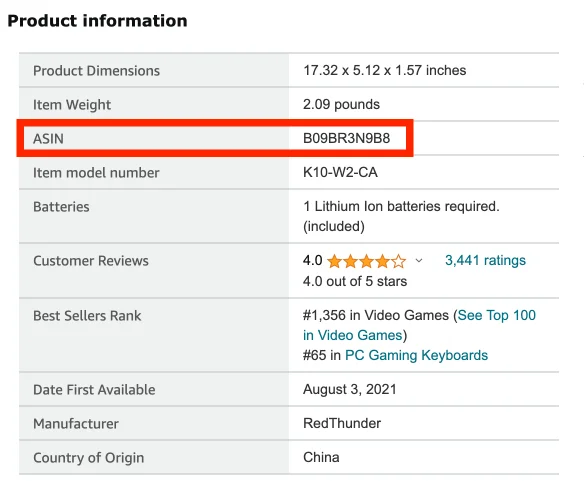Amazon’s product catalog continues to expand, featuring more than 12 million items. Each day, thousands of new ASINs come into existence for these products.
But what exactly is an Amazon ASIN, and why is it significant? How can one obtain an ASIN? All these crucial questions will be unraveled in this blog post.
What is an Amazon ASIN?
Amazon Standard Identification Number, or ASIN, is a 10-character alphanumeric code that Amazon uniquely assigns to every product on its platform. This system allows Amazon to efficiently manage its vast product catalog and ensures that each product is distinct.
ASIN vs UPC vs EAN
Unlike UPC (Universal Product Code) or EAN (European Article Number) that universally identify products, an ASIN is exclusive to Amazon. This means every product, whether sold by Amazon or third-party sellers, will have its unique ASIN.
What is the difference between a SKU and an ASIN?
While ASINs are Amazon-centric, SKUs (Stock Keeping Units) are what sellers use internally for their inventory.
- Purpose of SKUs: They identify your products within your internal systems, like your e-commerce platform or inventory management.
- Connection with ASINs: When you list a product on Amazon, you’ll provide your SKU. In turn, Amazon furnishes it with an ASIN.
Delving Deeper: Parent and Child ASINs
When browsing through Amazon, you might have seen products that offer multiple variations like size, color, or design. This is where the concept of Parent and Child ASINs comes into play.
- Parent ASIN: Think of it as an umbrella listing. It groups products that share a generic title and description.
- Child ASINs: These are the individual product variations under the parent listing. For instance, a t-shirt might have a parent ASIN that represents all available colors and sizes. Each specific color or size will then have its distinct child ASIN.
Why Amazon ASINs Matter
Learning how to find and understand Amazon ASINs is crucial for several reasons:
Product Identification
As previously mentioned, ASINs are unique identifiers for each product listed on Amazon. Learning to find and understand ASINs helps you accurately identify and locate specific products. This is essential for sellers looking to list their own products or customers searching for a particular item.
Product Listing
As a seller on Amazon, you need to create accurate and optimized product listings. Understanding ASINs is vital for creating new listings or linking your products to existing listings, ensuring that your items appear in relevant search results.
Competitive Analysis
Understanding Amazon ASINs allows you to analyze your competitors’ listings effectively. You can study their product titles, descriptions, images, and customer reviews associated with a specific ASIN to make informed decisions on pricing, product quality, and marketing strategies.
Inventory Management
For Amazon sellers, ASINs play a crucial role in managing inventory. By understanding ASINs, you can keep track of your stock levels and ensure that you have the right products in stock when customers order them.
SEO and Amazon ASIN Rankings
Every product on Amazon carries its own sales rank. This rank shows how a particular product fares against others in its category. The golden rule here: the lower the rank, the better.
- Parent ASIN Rankings: These reflect the combined sales data of all its child ASINs. A high rank for a parent ASIN indicates the popularity of its child products.
By understanding ASINs and how they relate to keywords and product descriptions, you can optimize your product listings for better visibility in search results.
Quality Control
When you can identify and understand ASINs, you can monitor product quality and customer feedback effectively. If customers report issues with specific ASINs, you can address those concerns promptly.
Sourcing
If you’re sourcing products from suppliers or wholesalers to sell on Amazon, knowing how to find and understand ASINs is crucial for identifying the exact products you want to sell and ensuring you’re receiving the correct inventory.
Enhanced Customer Experience
For buyers, understanding ASINs helps ensure they receive the precise products they ordered, reducing the likelihood of returns or dissatisfaction. It also allows customers to find and compare products more easily.
Legal and Compliance
ASINs are associated with various Amazon policies and rules. By understanding them, you can ensure your listings comply with Amazon’s guidelines, reducing the risk of account suspension or other penalties.
In sum, learning how to find and understand Amazon ASINs is fundamental for both sellers and customers. It facilitates accurate product identification, competitive analysis, and optimization of product listings. It also contributes to better quality control, a more efficient supply chain, and an improved overall shopping experience on Amazon.
How to Find Amazon ASINs?
An ASIN can be found through three (3) different methods – product information page, product listing URL, and an ASIN lookup tool.
Product Information
The ASIN can be located on nearly every Amazon product page, typically within the ‘Product Information’ section, under the ‘Additional Product Information’ box. This section also provides access to valuable data like the average customer rating, Amazon best-seller rank, and additional product details.

Product Listing URL
Find your desired item on Amazon, then select it from the search results to access the product’s details page. To find the unique identifier for the product, just locate the string of ten alphanumeric characters placed between two forward slashes (‘/’) in the URL.

After successfully finding the accurate product details in your search, you can utilize this information to create a product listing. Once Amazon grants approval for your listing, it becomes a part of your inventory, complete with a designated ASIN. This ASIN is not just a code for inventory identification; it also ensures your product’s visibility to Amazon customers.
In the scenario where your product lacks an existing ASIN in Amazon’s database, you must take the initiative to generate one. To achieve this, you will require knowledge of the product’s UPC, EAN, ISBN, or GTIN (Global Trade Item Number).
If you happen to be the product’s manufacturer, you’ll need to undergo UPC registration, which will enable you to create a unique ASIN for your item.
Gauging the Competitive Landscape: How to Use an Amazon ASIN Lookup Tool
The primary use of ASINs for Amazon sellers extends beyond product discoverability. ASINs serve as a means to size up your competitors. The ASIN assigned to your product aligns with those of competitors offering identical products.
These ASINs empower you to not only analyze your competitors but also to enhance your competitive edge by evaluating the product titles and keywords that yield the most favorable search rankings.
To gain valuable insights into your product’s online presence, consider leveraging an ASIN lookup tool that can aid you in optimizing your product ranking through improved descriptions and keywords.
For a more refined approach, use SellerTools to easily harness Amazon data for business growth. For instance, quickly access and prioritize competitor keywords to measure market competition. The system automatically imports and ranks keywords from rival products.
Here’s a step-by-step guide on how to use an ASIN lookup tool:
1. Select a Reliable ASIN Lookup Tool: Begin by choosing a reputable ASIN lookup tool or software like ManageByStats. Each tool provides different features and capabilities, so select the one that best suits your needs.
2. Input ASINs to Analyze: Enter the ASINs of the products you want to evaluate. You can enter multiple ASINs at once for a comprehensive analysis.
3. Retrieve Product Data: Initiate the lookup process. The tool will extract essential data related to the products associated with the provided ASINs. This data may include product titles, prices, sales rank, customer reviews, and more.
4. Analyze Competitor Metrics: Review the information gathered to assess the competitive landscape. Pay attention to factors such as:
- Product Pricing: Examine how your prices compare to competitors.
- Sales Rank: Analyze the popularity and demand for the products.
- Customer Review: Evaluate the quality and sentiment of reviews.
- Product Titles and Descriptions: Consider how competitors optimize their listings with keywords and engaging content.
- Fulfillment Method: Check whether products are fulfilled by Amazon (FBA) or the seller (FBM).
- Availability: Determine if competitors face issues with stockouts or frequently run out of inventory.
Competitive Landscape Analysis with an ASIN Lookup Tool
Identify Opportunities and Threats. Based on your own ASIN analysis, identify areas where you can outperform competitors. Look for opportunities to differentiate your product, offer a better price, or improve your listing’s content. Also, be aware of any potential threats, such as strong competitors with excellent reviews and low prices.
Track Changes Over Time. The competitive landscape on Amazon is dynamic. Regularly monitor and track changes in the data using an Amazon listing monitoring app like AMZAlert. This helps you adapt your strategies as market conditions evolve.
Refine Your Strategy. Use the insights gained from the ASIN lookup tool to refine your Amazon selling strategy. Whether it’s adjusting pricing, optimizing your product listings, or improving customer service, the data obtained will guide your decisions.
Stay Informed About Market Trends. Beyond assessing individual competitors, keep an eye on broader market trends. Understand customer preferences, emerging products, and changes in demand that can impact your strategy.
By consistently using a tool and following these steps, you’ll be well-equipped to navigate the competitive landscape on Amazon and make informed decisions to enhance your success as a seller.
Launching Your Brand: How Many ASINs to Begin With?
If you’re introducing a new brand to Amazon, quality always beats quantity.
New product launch: Experts suggest launching with one parent ASIN accompanied by 3-5 child ASINs.
For instance, a single parent ASIN for a shirt, with child ASINs distinguishing sizes and colors. Take it a step further with an off-Amazon advertising tool like PixelMe to significantly boost your new product’s rank on Amazon in 60 days! PixelMe enables sellers to add retargeting pixels and Urchin Tracking Module (UTM) parameters to their shortened links. This means you can track the behavior of people who click on your links and then retarget them with relevant ads.
Expansion: Once your primary listings gain momentum, consider diversifying your offerings by introducing more ASIN variations.
And as your business grows, it would be smart to use D8aDriven, an Amazon data analytics software, to effortlessly consolidate crucial data in a unified dashboard. Streamlining the process of collecting business data from diverse sources into a single user-friendly interface will help you gain a deeper understanding of your sales, marketing, operations, and financial aspects, enabling you to swiftly make well-informed decisions.
Amazon ASINs: The Path to Greater Visibility on Amazon
Amazon ASINs play a pivotal role in Amazon’s ecosystem, from organizing its colossal catalog to tracking inventory. For sellers, mastering the nuances of ASINs, understanding parent-child relationships, and using rankings to your advantage can make all the difference in optimizing visibility.
When launching on Amazon, start with a minimalist ASIN strategy, ensuring each listing is optimized to its fullest. And always remember the crucial distinction between SKUs and ASINs to streamline your operations across different sales platforms.





